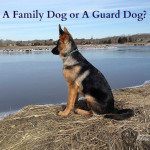Give Your Dog Clean Teeth For Life in Sixty Seconds a Day
It's more than clean teeth, it's your dog's overall health.
One minute a day, seven minutes a week - that’s all it takes to help your dog fight tooth decay and disease. You can do so much good in so little time, so why not make this the year you finally learn how to brush your dog's teeth? According to veterinarians, when you set aside just seven minutes a week, you can prevent many painful conditions. The best part is that your dog will thank you every day with sweet-smelling kisses for life!
If you're unsure about how to brush your dog's teeth, don't worry; with practice you'll see that scrubbing those chompers is pretty easy on large-mouthed, bigger dogs. I know, because after seven years of brushing my German Shepherd Dog’s teeth on an (almost) nightly basis, it's a simple routine for us.
Why Learning to Brush Your Dog's Teeth Matters
My Wyatt is seven years old and with permission from his vet, he's never needed a professional dental cleaning. His predecessor, Jerry, lived to 10 years old and he, too, had sparkly teeth into old age. Was it good genes that enabled them to skip their annual vet cleaning? Maybe. But the bigger reason is from the time they were puppies we took sixty seconds out of our day to care for their teeth. I'll confess to skipping the tooth brushing more than once, but for the most part it's been our special daily bonding time.
Dogs Need to Brush Daily, Just Like Us
Daily tooth brushing not only helps avoid common canine periodontal diseases, but familiarizes us with our dog's mouths so we can spot signs of really big issues like oral cancers common in dogs. Since fifty percent of dogs will die from cancer this year alone, learning to how brush your dog's teeth is one of the best ways to avoid becoming a statistic. But before getting stared with home dental care, make sure your dog has a complete oral exam and cleaning by your vet. When you start with clean teeth, it's fairly easy to keep them that way on your own.
Use the Right Tools for the Job
Your favorite pet supply store will carry the right tooth brushing supplies for dogs, and the good news is they are inexpensive when compared to the cost of a tooth extraction. You'll find special pet toothpastes with peanut butter, poultry or beef flavoring, as well as enzymatic gels which, in my opinion, work best. They contain a special chemical to introduce hydrogen peroxide into your dog's mouth that according to VetInfo.com, “activates enzymes in the lactoperoxidase (a milk-based enzyme) to help reduce the growth of microorganisms in your dog’s mouth.”
Whatever you decide to buy, never use human toothpaste or baking soda to brush your dog's teeth! Both taste horrible to dogs and can really mess up their digestive system.
Pet stores also have special dog toothbrushes. Some look just like human toothbrushes, but with sharper angles and more bristles to accommodate large canine teeth. Others are just little plastic finger coverings with brushes that you gently swoosh over your dog's teeth. Finger brushes are all I've ever used for Wyatt because he thinks regular toothbrushes are chew toys. You may need to try a few different dog toothpastes and brushes before discovering one that your dog tolerates. Always replace your brushes at least as regularly as you replace yours, if not more often.
Make Tooth Brushing a Routine: Choose a Specific Time
Try to brush your dog's teeth at a specific time each day, when he is most mellow. Our Wyatt is most accommodating after dinnertime while lounging on the couch. Your dog might be mellower during mid-day. Study your dog's routine to find a time that seems promising.
If you make tooth brushing a fun activity because your dog thinks toothpaste tastes good, he won't mind after a while. I always let Wyatt lick some off the brush before we get started so he thinks he's getting a treat. Just use a confident and high-spirited approach, but keep it short and sweet.
Many veterinarians share dog tooth brushing practice tips like these to help your pup get comfortable with the first few sessions. If your dog still resists, your vet will be happy to share tips at your next visit. Just relax, make it fun and focus your efforts on on the outside of your dog's teeth where most problems occur. The rough surface of a dog's tongue does all the hard work inside the teeth so you don't have to. For extra fresh breath, let your dog lick the toothbrush when you're done so his tongue gets brushed, too.
Herding breeds learn so quickly, so there's no reason why yours won't adapt to this routine. The hardest part about brushing your dog's teeth is committing to the routine. However, once you see those sparkling teeth, smell their fresh breath and your vet applauds you for keeping your dog free from periodontal disease, you'll see that this daily chore really is worth the time and effort.
Article By:
Rene Agredano







